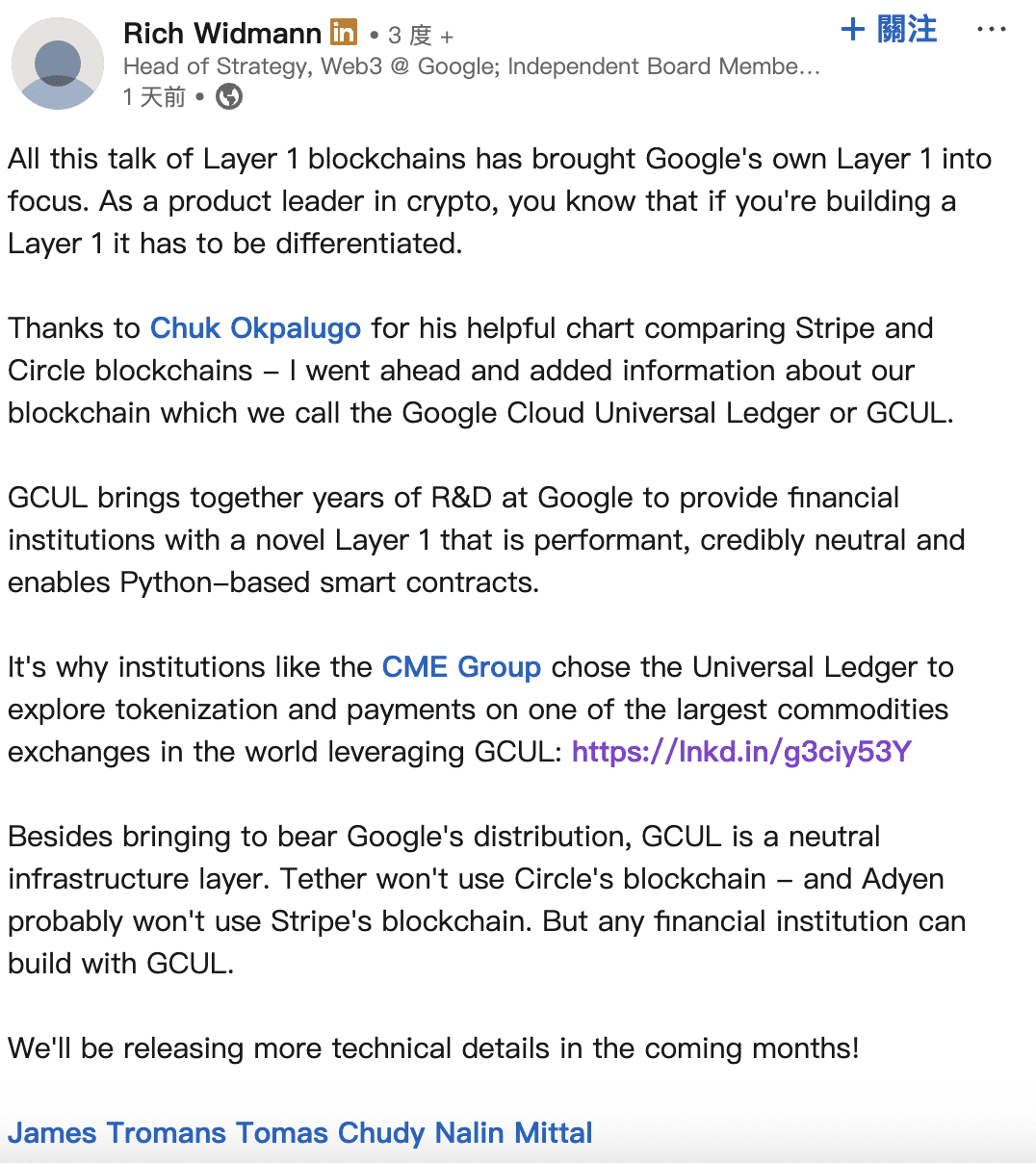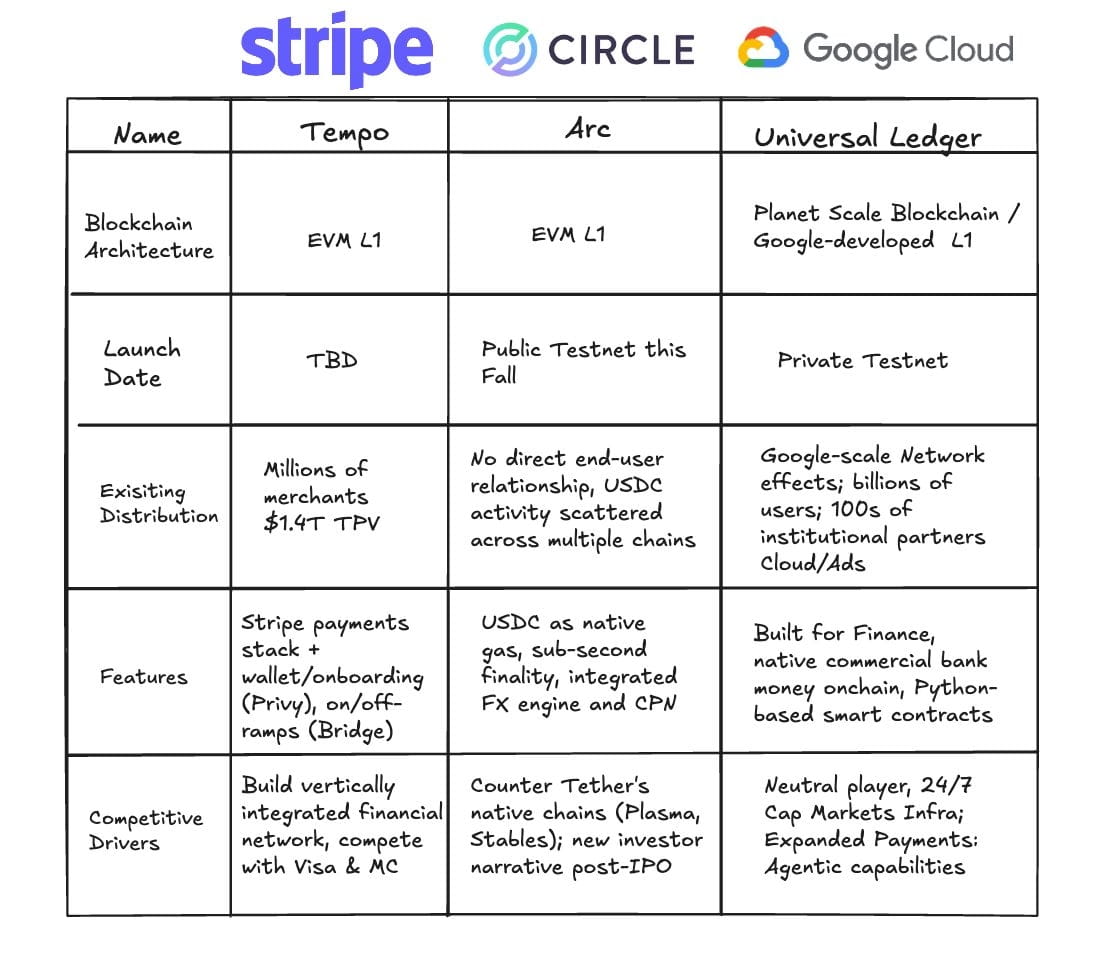Google officially enters the blockchain infrastructure space, GCUL targets institutional clients
Google Cloud officially announced the launch of its own Layer 1 blockchain 'Google Cloud Universal Ledger' (GCUL), a high-performance blockchain platform designed for financial institutions. Rich Widmann, head of Google Web3 strategy, confirmed in a LinkedIn post that GCUL is a 'high-performance, trust-neutral' blockchain that supports Python-based smart contracts and is currently operating in a private testnet phase.
 Source: LinkedIn Rich Widmann, head of Google Web3 strategy, confirms the launch of Google's own Layer 1 blockchain 'GCUL'
Source: LinkedIn Rich Widmann, head of Google Web3 strategy, confirms the launch of Google's own Layer 1 blockchain 'GCUL'
This initiative is the culmination of years of research and development at Google, symbolizing the tech giant's direct entry into the blockchain infrastructure industry. Unlike traditional public chains, GCUL operates on a permissioned private network and provides services through a unified API, allowing financial institutions to connect to the system without needing to maintain their own infrastructure.
The core features of GCUL include simplicity, flexibility, and security. The platform supports multiple currencies and asset types, with programmable features that allow institutions to directly build payment automation and digital asset workflows on it. Additionally, the system includes compliance requirements such as KYC verification, promising low-cost, near-instant 24/7 trading services for end users.
Neutral positioning becomes a key strategy, avoiding competitor ecosystems
Widmann emphasized that GCUL's unique positioning lies in its neutrality, which is a core strategic element of the platform.
He pointed out: 'Tether will not use Circle's blockchain, and Adyen may not use Stripe's blockchain, but any financial institution can build applications on GCUL.'
This strategy of neutral infrastructure reflects the reality of the financial industry: competitors rarely build applications on each other's proprietary blockchains. Google, with its neutral supplier position in the cloud services and infrastructure industry, provides a secure foundation for any financial institution to build on.
Compared to Circle's Arc and Stripe's Tempo, GCUL has taken a distinctly different route. Circle's Arc centers around the $USDC stablecoin, promising lightning-fast settlement speeds and built-in currency exchange features. Stripe's Tempo is rooted in its payment empire, extending its existing merchant network to a vertically integrated blockchain. In contrast, Google's GCUL is designed as a shared infrastructure layer, intended to be a trustworthy neutral platform that any institution can utilize.
 Source: Rich Widmann GCUL compared with Stripe and Circle
Source: Rich Widmann GCUL compared with Stripe and Circle
CME Group takes the lead in piloting, full commercial use in 2026
GCUL has completed initial integration testing with the Chicago Mercantile Exchange (CME Group). In March of this year, Google Cloud and CME Group jointly announced this collaboration, positioning GCUL as a programmable distributed ledger tailored for wholesale payments and asset tokenization.
CME Group has completed the first phase of integration and testing, describing the technology as a potential breakthrough for the collateral, settlement, and fee payment industry, especially as the market increasingly shifts towards 24/7 trading. CME Chairman and CEO Terry Duffy stated that GCUL can offer significant efficiency improvements in core market functions, including margin and collateral management.
According to the timeline, CME and Google plan to start direct testing with market participants later this year, aiming to launch full services in 2026. This timeline is more conservative compared to Circle's Arc (which has begun piloting) and Stripe's Tempo (expected to launch next year), but it also reflects Google's cautious approach towards institutional-grade applications.
Python smart contracts become a differentiated advantage, challenging existing L1 solutions
GCUL's choice to support Python smart contracts stands in stark contrast to industry standards. Most blockchains use programming languages such as Solidity (Ethereum-compatible chains) or Rust (like Solana, Aptos, and Sui). The choice of Python is seen as a 'pragmatic' decision, as it lowers the entry barrier for enterprises and fintech developers already using Python for data, finance, and machine learning.
This technology choice may accelerate the experimental process but could also lead to a fragmented developer ecosystem unless Google provides robust tools, auditing, and cross-chain interoperability. Industry experts view this as a 'reverse bet' since GCUL does not choose EVM compatibility but relies on Google's scale, reach within financial institutions, and differentiated programming model.
As Google officially enters the Layer 1 blockchain competition, the competitive landscape with fintech giants like Stripe and Circle is rapidly taking shape. Although the three are not direct competitors, they are all carving out different segments of the institutional blockchain infrastructure market. The success of GCUL will ultimately depend on the upcoming technical specifications and subsequent market adoption.
The article 'Searching for the King of Search Without Competing for C-end! Google Launches GCUL Public Chain, Is It for Financial Giants?' was first published in 'Crypto City'


